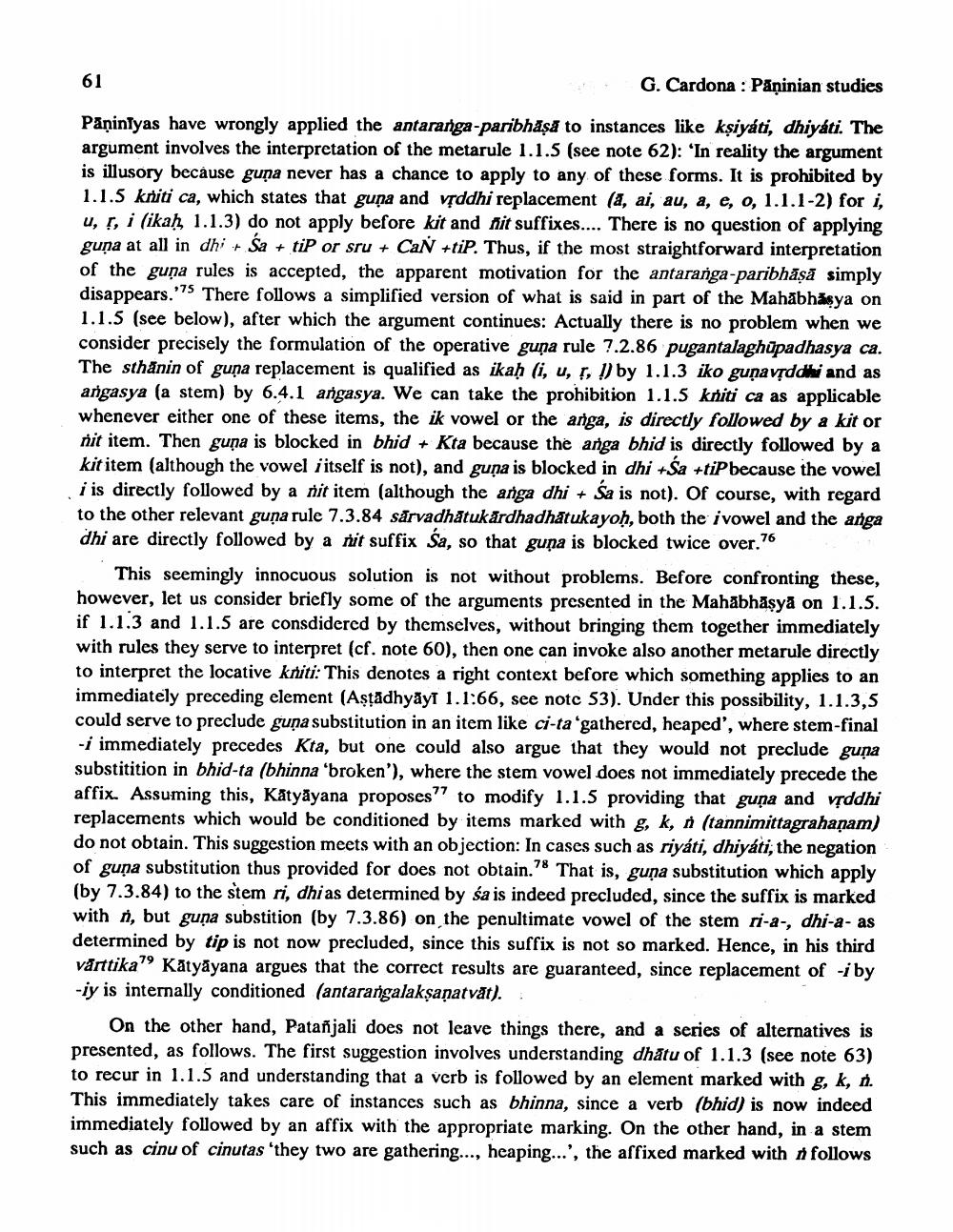________________
G. Cardona : Paninian studies
Paniniyas have wrongly applied the antaranga-paribhasa to instances like kṣiyáti, dhiyáti. The argument involves the interpretation of the metarule 1.1.5 (see note 62): 'In reality the argument is illusory because guna never has a chance to apply to any of these forms. It is prohibited by 1.1.5 kniti ca, which states that guna and viddhi replacement (a, ai, au, a, e, o, 1.1.1-2) for i, u, r, i (ikah, 1.1.3) do not apply before kit and nit suffixes.... There is no question of applying guna at all in dhi Sa + tip or sru + CaN +tip. Thus, if the most straightforward interpretation of the guna rules is accepted, the apparent motivation for the antaranga-paribhasa simply disappears." There follows a simplified version of what is said in part of the Mahabhasya on 1.1.5 (see below), after which the argument continues: Actually there is no problem when we consider precisely the formulation of the operative guna rule 7.2.86 pugantalaghapadhasya ca. The sthänin of guna replacement is qualified as ikah (i, u, r, by 1.1.3 iko gunavṛddhi and as angasya (a stem) by 6.4.1 angasya. We can take the prohibition 1.1.5 kniti ca as applicable whenever either one of these items, the ik vowel or the anga, is directly followed by a kit or nit item. Then guna is blocked in bhid + Kta because the anga bhid is directly followed by a kit item (although the vowel /itself is not), and guna is blocked in dhi SatiPbecause the vowel i is directly followed by a nit item (although the anga dhi+ Sa is not). Of course, with regard to the other relevant guna rule 7.3.84 sarvadhatukärdhadhatukayoh, both the ivowel and the anga dhi are directly followed by a nit suffix Sa, so that guna is blocked twice over. 76
61
This seemingly innocuous solution is not without problems. Before confronting these, however, let us consider briefly some of the arguments presented in the Mahabhäṣyä on 1.1.5. if 1.1.3 and 1.1.5 are consdidered by themselves, without bringing them together immediately with rules they serve to interpret (cf. note 60), then one can invoke also another metarule directly to interpret the locative kniti: This denotes a right context before which something applies to an immediately preceding element (Astädhyay 1.1:66, see note 53). Under this possibility, 1.1.3,5 could serve to preclude guna substitution in an item like ci-ta'gathered, heaped', where stem-final -i immediately precedes Kta, but one could also argue that they would not preclude guna substitition in bhid-ta (bhinna "broken"), where the stem vowel does not immediately precede the affix. Assuming this, Katyayana proposes" to modify 1.1.5 providing that guna and viddhi replacements which would be conditioned by items marked with g. k, n (tannimittagrahanam) do not obtain. This suggestion meets with an objection: In cases such as riyáti, dhiyáti, the negation of guna substitution thus provided for does not obtain." That is, guna substitution which apply (by 7.3.84) to the stem ri, dhias determined by sa is indeed precluded, since the suffix is marked with n, but guna substition (by 7.3.86) on the penultimate vowel of the stem ri-a-, dhi-a- as determined by tip is not now precluded, since this suffix is not so marked. Hence, in his third värttika" Katyayana argues that the correct results are guaranteed, since replacement of iby. -iy is internally conditioned (antarangalakṣaṇatvar).
On the other hand, Patanjali does not leave things there, and a series of alternatives is presented, as follows. The first suggestion involves understanding dhatu of 1.1.3 (see note 63) to recur in 1.1.5 and understanding that a verb is followed by an element marked with g, k, n. This immediately takes care of instances such as bhinna, since a verb (bhid) is now indeed immediately followed by an affix with the appropriate marking. On the other hand, in a stem such as cinu of cinutas 'they two are gathering..., heaping...', the affixed marked with follows




